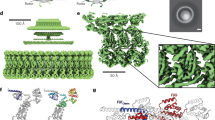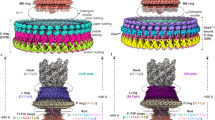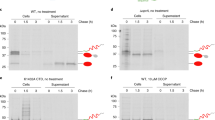Abstract
BACTERIA move by rotation of a spiral flagellum1,2. The flagellar motor1 is thought to be a basal body consisting of a rod with four threaded rings localised in the cell wall and connected to the flagellum3,4. Larsen et al.4 have found that the source of energy for motility is an intermediate of oxidative phosphorylation rather than ATP. The idea that an ion gradient is the basis of bacterial movement originates from Mitchell5, and has been favoured by several authors6–8. Some indications of the direct coupling between the H+ electrochemical gradient (Δμ̄H+) and motility were obtained in our laboratory when we were studying a photosynthetic bacterium, Rhodospirillum rubrum7,9,10. We describe here experiments demonstrating that bacterial motility can be supported by enzymatically generated or artificially imposed constituents of Δμ̄H+, that is, electric potential (ΔΨ) or Δ pH.
This is a preview of subscription content, access via your institution
Access options
Similar content being viewed by others
References
Berg, H. C. Nature 254, 389–392 (1975).
Silverman, M. & Simon, N. I. Nature 249, 73–74 (1974).
De Pamphilis, M. L. & Adler, J. J. Bact. 105, 384–395 (1971).
Larsen, S. H., Adler, J., Gargus, I. I. & Hogg, R. W. Proc. natn. Acad. Sci. U.S.A. 71, 1239–1243 (1974).
Mitchell, P. Proc. R. phys. Soc. Edinb. 25, 32–34 (1956).
Mitchell, P. FEBS Lett. 28, 1–5 (1972).
Skulachev, V. P. Proc. FEBS Meet. 10, 225–238 (1975).
Liberman, E. A. Biofizika 20, 1132–1133 (1975).
Skulachev, V. P. FEBS Lett. 74, 1–9 (1977).
Belyakova, T. N., Glagolev, A. N. & Skulachev, V. P. Biokhimia 41, 1478–1483 (1976).
Shoemith, J. G. J. gen. Microbiol. 22, 528–532 (1960).
Valle-Tascon, S., Gimenes-Galego, G. & Ramires, J. M. Biochem. biophys. Res. Commun. 66, 514–519 (1975).
Drachev, L. A. et al. Analyt. Biochem. (1977).
Maloney, P. C. & Wilson, T. H. J. Membrane Biol. 25, 285–310 (1975).
Manson, M. D. et al. Proc. natn. Acad. Sci. U.S.A. 74, 3060–3064 (1977).
Author information
Authors and Affiliations
Rights and permissions
About this article
Cite this article
GLAGOLEV, A., SKULACHEV, V. The proton pump is a molecular engine of motile bacteria. Nature 272, 280–282 (1978). https://doi.org/10.1038/272280a0
Received:
Accepted:
Issue date:
DOI: https://doi.org/10.1038/272280a0
This article is cited by
-
Architecture of the flagellar rotor
The EMBO Journal (2011)
-
Chemiosmotic concept of the membrane bioenergetics: What is already clear and what is still waiting for elucidation?
Journal of Bioenergetics and Biomembranes (1994)
-
Bioenergetics: the evolution of molecular mechanisms and the development of bioenergetic concepts
Antonie van Leeuwenhoek (1994)
-
Chemiosmotic systems in bioenergetics: H+-cycles and Na+-cycles
Bioscience Reports (1991)
-
Coupling of proton flow and rotation in the bacterial flagellar motor: stochastic simulation of a microscopic model
European Biophysics Journal (1990)



